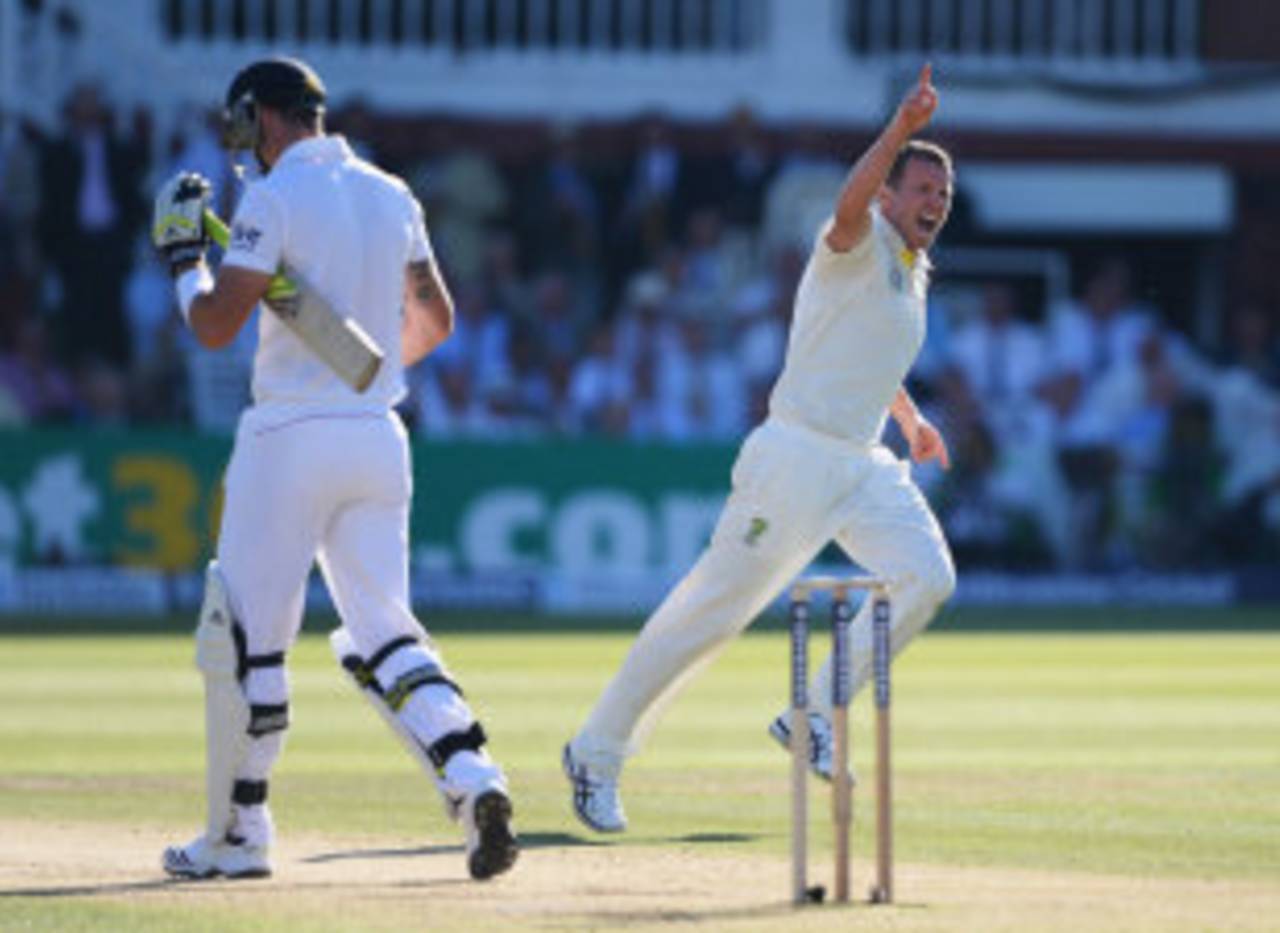So far in the Ashes, it's clear that England have been the better team. Australia dominated the
third Test and were denied a chance to press for victory by the weather, but England were far superior in the
second, while the
first Test became close only because of two splendid - but completely unexpected - last-wicket partnerships. England have had the better top-order batsmen and the better spinner - both by a considerable margin - but the one area in which they have been second-best in the three Tests is the fast-bowling department. Familiarity with the Dukes ball and the conditions should have been an advantage for James Anderson and Co, but so far the Australian quicks - led by Peter Siddle and Ryan Harris - have trumped them, taking more wickets at a better average, strike rate and economy rate. (Click
here for the series averages for Australia, and
here for England.)
Coming into the series, fast bowling was always expected to be Australia's greatest strength, but there was also plenty of expectations on them given that the team's batting and spin bowling looked much weaker than England's, on paper at least. In the first three Tests, the pace attack has withstood the pressure well. Despite bowling at batsmen who are clearly better equipped at playing pace and swing than their own, the Australian attack has excelled, taking 43 wickets at 27.51. They have also maintained the pressure by keeping the scoring rate under check, going at only 2.69 runs per over.
The stars have clearly been Harris and Siddle. Harris'
11 wickets have come at 18 apiece, and only two of his 11 wickets have been lower-order batsmen. Harris has been especially effective against Jonathan Trott, and is the main reason why Trott has scored only 122 from six innings in the series so far - Harris has dismissed him three times conceding only 16 runs from 33 balls. Siddle is Australia's
leading wicket-taker with 16, at an average of 21.68, and has had exceptional success against Kevin Pietersen and Matt Prior, dismissing each three times. (He has dismissed Pietersen seven times in all Tests, at an average of 17.42 runs per dismissal.) Shane Watson has taken only one wicket in 61 overs, but he has contributed immensely in keeping it tight, going at 1.86 runs per over.
England's pace attack, on the other hand, hasn't been as effective as expected against a less-than-formidable batting line-up. However, Graeme Swann has more than made up for that, taking
19 wickets - the most by any bowler in the series - at an average of 27.36. Swann has been particularly potent against the left-handers - and there are plenty of those in the Australian squad: 11 of his 19 wickets have been those of left-handers, at an average of 18; against right-handers, he has conceded 40 runs per wicket. James Anderson has been the clear leader among England's fast bowlers, with
15 wickets at 26, including two five-fors and a ten-wicket haul. The batsmen he has dismissed most often are the lower-order ones (though in Australia's case it could be argued that the tail has offered more resistance than some of the top-order batsmen): Siddle has fallen four times to Anderson, and Starc three times. In terms of bowling stats, the disappointments for England have been Steven Finn (two wickets at an average of 58.50) and Stuart Broad (six wickets at 52), though Broad has clearly bowled better than those numbers suggest and has had more success against Michael Clarke than any other England bowler.
Many experts have spoken about this Australian unit being one of the worst to tour England, but as a fast-bowling unit this team has outdone five of the last nine, and each of the last three sides which came to England. The last time an Australian fast-bowling attack averaged less than 27 in England was in 1997, when the
pace line-up included Glenn McGrath, Jason Gillespie and Michael Kasprowicz. McGrath had an outstanding series, taking 36 wickets at 19.47, Gillespie averaged 20.75 and Kasprowicz 22.14. With Paul Reiffel in the mix, the pace attack took 77 wickets at less than 23.
England's best in the last few home Ashes was in 2005, when their
four-man combination of Simon Jones, Andrew Flintoff, Steve Harmison and Matthew Hoggard took 75 wickets at 27.89. Australia had a strong attack on paper too, with McGrath, Gillespie, Kasprowicz, Brett Lee and Shaun Tait, but McGrath's injury after a couple of matches and Gillespie's poor form meant they were clearly second-best in the series. England's worst displays were in 1989 and 1993, when they conceded more than 50 runs per wicket; over those two series, England were thrashed by a 1-8 margin.
In terms of the batting by their top six, though, Australia's stats so far in the series is their worst since 1981, when they averaged 30.17 in the series. Clarke's century has been their only one in three Tests so far, though Australia's batsmen have two Tests to improve that tally. The last time they scored only one hundred in an Ashes series in England was in 1968: in a series that was drawn 1-1, Bill Lawry's 135 was the only century, though
Australia's batsmen went past fifty 15 times in that series.
England's top six are having their best Ashes since 1985, when they averaged 56.70. With Cook and Trott averaging less than 25, though, there's plenty of room for improvement. For that to happen, they'll have to do a much better job against Australia's pace attack.
